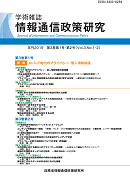The Act to Partially Amend the Radio Act and the Broadcasting Act which was approved by the 208th ordinary session of the Diet, is composed of five elements; (1) Strengthening the functions of the Radio Regulatory Council, (2) Creating a system for reassigning frequencies for mobile phones and other systems, (3) Revising the Spectrum User Fee system, (4) Revising restrictions on foreign investment in the information and telecommunications sector, (5) Arranging for mechanisms to ensure the appropriate and fair sharing of NHK Subscription Fees, and other related amendments.
Specifically, as for (1), up until now, assessments regarding the degree to which radio spectrum is being utilized effectively have been implemented by the Minister of Internal Affairs and Communications based on the results of actual utilization surveys; under the amended Radio Act, the assessments will be implemented by the Radio Regulatory Council, which is made up of council members who have broad-ranging experience and knowledge, in order to allow for the implementation of more appropriate assessments that are adapted to matters such as technological progress. The amending act enables the Radio Regulatory Council to make the necessary recommendations to the Minister of Internal Affairs and Communications regarding effective utilization assessments, and requires the Minister to report to the Council on measures taken based on its recommendations.
As for (2), the amending act makes it possible to reassign frequencies that are being used by base stations, for telecommunications operations involving devices such as mobile phones, under the following cases:
- If the result of an effective utilization assessment by the Radio Regulatory Council does not meet certain standards.
- If the Minister of Internal Affairs and Communications determines that a reassignment review is necessary based on a competing application.
- If the Minister of Internal Affairs and Communications determines that frequencies for mobile phones and other systems need reassigning to ensure fair and efficient use of radio waves
In addition, the amendment newly establishes a system for allowing requests for reassignment reviews. Under the amended act, information for ensuring fair use of the radio spectrum, such as information on the maximum bandwidth that each business can apply for in consideration of the aggregate bandwidth they already hold, is added as information that is to be included in the establishment guidelines for mobile phones and other systems.
As for (3), the amending act modifies spectrum user fees while taking into account matters such as aggregate expenses for spectrum users’ common benefit in the next three years (FY2022 to FY2024) and the expected operational status of radio stations.
The amendment makes it possible to use spectrum user fees to issue grants for research and development that are aimed at matters such as the realization of Beyond 5G (6G).
As for (4), the amending act adds the ratio of foreign capital and foreign officers as information that is required to be given on applications for certification for basic broadcasting operations, applications for radio station licenses, and elsewhere, and makes it mandatory to provide notifications regarding changes in matters such as the ratio of foreign capital. Moreover, the act arranges for corrective measures upon violation of restrictions on foreign investment.
View PDF for the rest of the abstract
View full abstract
